|
setSC-Balanophora_fungosa-4
|
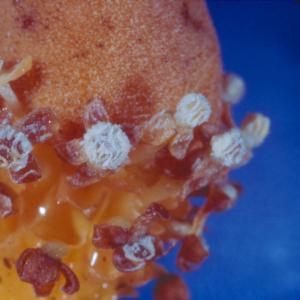
|
At a higher magnification, details of the male flowers and the female flowers on this flowering stalk of Balanophora fungosa become evident. The surface of the portion bearing female flowers, above, now can be seen to consist of small structures.
Return to the Balanophora fungosa page or the Parasitic Plant Index.
|
copyright: Carlquist, BSA
license: http://images.botany.org/index.html#license |
Image
|
Parasitic Plants

|

|
|
setSC-Balanophora_fungosa-5
|
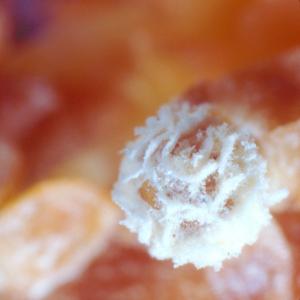
|
A male flower of Balanophora fungosa at very high magnification. Out of focus are a few of the brown petal-like structures. The white globe consists of the structures bearing pollen, the anthers, which have opened and look like papery scales. With a little imagination, you can see white pollen grains among those scale-like structures.
Return to the Balanophora fungosa page or the Parasitic Plant Index.
|
copyright: Carlquist, BSA
license: http://images.botany.org/index.html#license |
Image
|
Parasitic Plants

|

|
|
setSC-Balanophora_fungosa-6
|
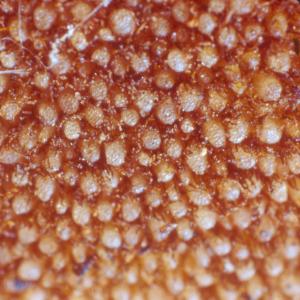
|
A small portion of the flowering stalk of Balanophora fungosa, showing female flowers at very high magnification. There are two kinds of structures here, which differ in size. The bigger ones are structures that are difficult to name. We don't know what they represent for sure--are they like petals, or are they some other kind of formation? The tiny structures are the female flowers. If not the tiniest flowers in the world of flowering plants, they are close to being the tiniest.
Return to the Balanophora fungosa page or the Parasitic Plant Index.
|
copyright: Carlquist, BSA
license: http://images.botany.org/index.html#license |
Image
|
Parasitic Plants

|

|
|
setSC-Boschniakia_strobilacea-1
|
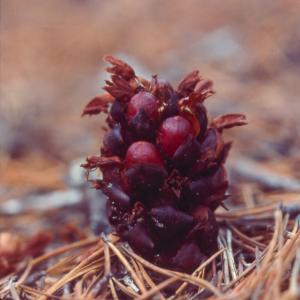
|
This dark purple plant is Boschniakia strobilacea. It's sometimes called ground cone, perhaps because the incurved purple leaves make the plant look like a cone--but above each leaf is a flower. Boschniakia belongs to the Orobanchaceae (broomrape family). Boschniakia has no chlorophyll, and is parasitic on the roots of members of the heath family such as arbutus, manzanita, and salal. Boschniakia has no roots, and a large thick base attaches directly to the roots of the host plant.
Return to the Boschniakia strobilacea page or the Parasitic Plant Index.
|
copyright: Carlquist, BSA
license: http://images.botany.org/index.html#license |
Image
|
Parasitic Plants

|

|
|
setSC-Boschniakia_strobilacea-2
|
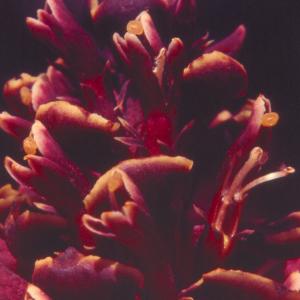
|
The flowers are similar in shape to those of snapdragon, and the family to which Boschniakia belongs, Orobanchaceae, is closely related to the family to which snapdragons and penstemons belong (Scrophulariaceae). Also, some partially parasitic flowering plants that are green, such as Indian Paint Brush (Castilleja) now are placed in Orobanchaceae. There are four species of Boschniakia. They occur in northwestern North America and in northeastern Asia.
Return to the Boschniakia strobilacea page or the Parasitic Plant Index.
|
copyright: Carlquist, BSA
license: http://images.botany.org/index.html#license |
Image
|
Parasitic Plants

|

|
|
setSC-Boschniakia_strobilacea-3
|
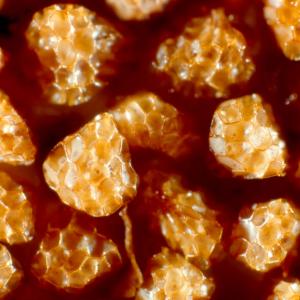
|
The seeds of Boschniakia are very small. They are greatly enlarged in this photograph, which shows that the seed surface consists of interlocking polygonal ridges. This structural feature probably helps them in dispersing, perhaps in wind, but there has been no study done on how Boschniakia disperses or how these seeds would behave in a current of air.
Return to the Boschniakia strobilacea page or the Parasitic Plant Index.
|
copyright: Carlquist, BSA
license: http://images.botany.org/index.html#license |
Image
|
Parasitic Plants

|

|
|
setSC-Byblis_gigantea-1
|
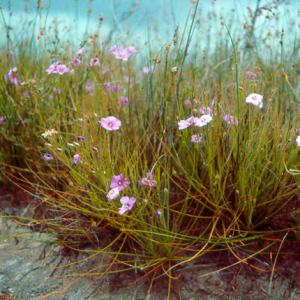
|
Byblis gigantea grows in southwestern Australia. It's a perennial plant that likes areas of acid sand that dry out in summertime. Often not a typical bog plant, it can be found in shrubby areas as well as open areas of white sand.
Return to the Byblis page or the Carnivorous Plant Index.
|
copyright: Carlquist, BSA
license: http://images.botany.org/index.html#license |
Image
|
Carnivorous Plants

|

|
|
setSC-Byblis_gigantea-2
|
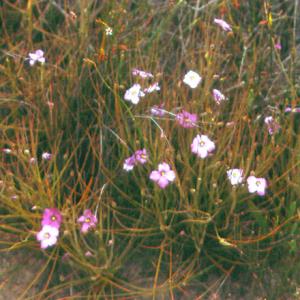
|
Byblis gigantea can grow in dense groupings. Its narrow leaves are covered on all surfaces by sticky hairs that trap insects. Thus, any insect passing through such a mass of leaves is likely to be trapped. sticky hairs do not change position once the insect is caught. The insect is gradually digested where it landed.
Return to the Byblis page or the Carnivorous Plant Index.
|
copyright: Carlquist, BSA
license: http://images.botany.org/index.html#license |
Image
|
Carnivorous Plants

|

|
|
setSC-Byblis_gigantea-3
|
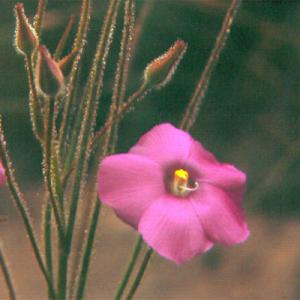
|
The leaves as well as the outer floral structures (sepals) of the flowers of Byblis gigantea are densely covered with sticky hairs. The flowers of Byblis are red-purple, and are probably attractive to a kind of bee.
Return to the Byblis page or the Carnivorous Plant Index.
|
copyright: Carlquist, BSA
license: http://images.botany.org/index.html#license |
Image
|
Carnivorous Plants

|

|
|
setSC-Byblis_gigantea-4
|
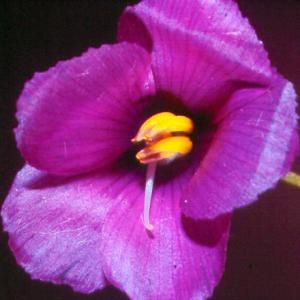
|
The flowers of Byblis gigantea look symmetrical at first glance. However, we see that the style (white) and the stamens (yellow) curve to use side of the flower. This curvature provides an approach pattern for a bee, orienting it so that it will get showered with pollen or deposit the pollen on the tip of the style.
Return to the Byblis page or the Carnivorous Plant Index.
|
copyright: Carlquist, BSA
license: http://images.botany.org/index.html#license |
Image
|
Carnivorous Plants

|

|
|
setSC-Byblis_gigantea-5
|
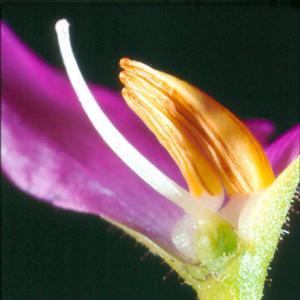
|
In a sectional view, we se the stamens and the style curving in different directions. The wide white stamen bases are curved and are responsible for the way that the stamens are arranged with relations to an incoming insect.
Return to the Byblis page or the Carnivorous Plant Index.
|
copyright: Carlquist, BSA
license: http://images.botany.org/index.html#license |
Image
|
Carnivorous Plants

|

|
|
setSC-Byblis_gigantea-6
|
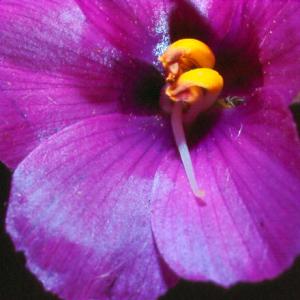
|
The stamens of Byblis gigantea don't open by slits. Rather, they have flaring holes at their tips. Byblis is one of a few flowering plants that have what is known as buzz pollination. In this process, the insects of an insect beat at frequencies that set the stamens in motion. As the stamens vibrate, the pollen grains shake out and dust the surfaces of the insect and catch on its hairs.
Return to the Byblis page or the Carnivorous Plant Index.
|
copyright: Carlquist, BSA
license: http://images.botany.org/index.html#license |
Image
|
Carnivorous Plants

|

|
|
setSC-Byblis_linifolia-7
|

|
Byblis linifolia grows in Queensland, in northeastern Australia. It likes acid sand areas, but often grows in a straggling fashion.
Return to the Byblis page or the Carnivorous Plant Index.
|
copyright: Carlquist, BSA
license: http://images.botany.org/index.html#license |
Image
|
Carnivorous Plants

|

|
|
setSC-Byblis_linifolia-8
|
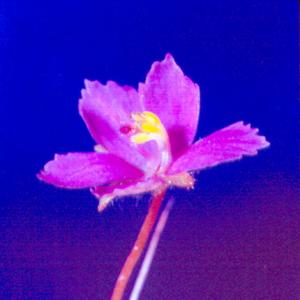
|
The flowers of Byblis linifolia are smaller than those of B. gigantean. The petals are fringed. Like B. gigantean, the stamens of Byblis linifolia have a curved shape and are adapted to buzz pollination.
Return to the Byblis page or the Carnivorous Plant Index.
|
copyright: Carlquist, BSA
license: http://images.botany.org/index.html#license |
Image
|
Carnivorous Plants

|

|
|
setSC-Cephalotus-1
|
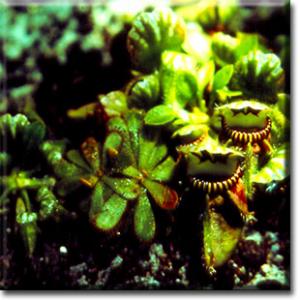
|
Cephalotus is known as the Albany Pitcher Plant. It grows only near the town of Albany, in southwestern Australia. It isn't related to other pitcher plants, although it has some features that resemble them. In this picture, you can see, at the center, the "ordinary" leaves, which are just flat, as well as some of the leaves which have the pitcher form and can catch insects.
|
copyright: Carlquist, BSA
license: http://images.botany.org/index.html#license |
Image
|
Carnivorous Plants

|

|
|
setSC-Cephalotus-10
|
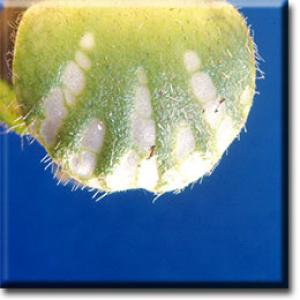
|
With some light beneath the lid as well as on its surface, the window-like nature of the translucent areas is clearly evident. Interestingly, the same feature can be found in the lids of the unrelated North American pitcher plants Darlingtonia and Sarracenia.
|
copyright: Carlquist, BSA
license: Http://images.botany.org/index.html#license |
Image
|
Carnivorous Plants

|

|
|
setSC-Cephalotus-11
|
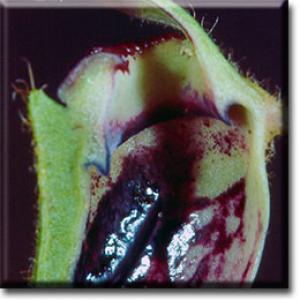
|
To see why the pitcher of Cephalotus is such a good trap, let's look at a section of the pitcher, starting at the top. At the top, we see a piece of the lid. Then, not far below, the reddish-purple mouth. It not only has slippery surfaces, it has some tiny downwardly-pointing teeth arching over the pitcher, so that an insect tends to return to the pitcher rather than escapee from it. And then, below that, there's one more device to keep an insect inside--a second rim.
Below that, the purple and whitish surfaces of the pitcher are difficult for an insect to climb. It an insect isn't caught immediately by the pool, it will tend to buzz around in the pitcher, fooled by the "windows" in the lid, and will probably fail to climb out and will tire enough so that eventually it will fall into the liquid pool at the bottom of the pitcher.
|
copyright: Carlquist, BSA
license: http://images.botany.org/index.html#license |
Image
|
Carnivorous Plants

|

|
|
setSC-Cephalotus-2
|
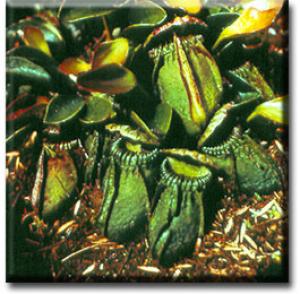
|
The pitchers of Cephalotus nestle close to each other and are usually found in moss at ground level. The Albany pitcher plant grows in scrubby areas that are moist all year around, on sandy soils that are acid--a habitat rather like that of many other carnivorous plants.
|
copyright: Carlquist, BSA
license: http://images.botany.org/index.html#license |
Image
|
Carnivorous Plants

|

|
|
setSC-Cephalotus-3
|
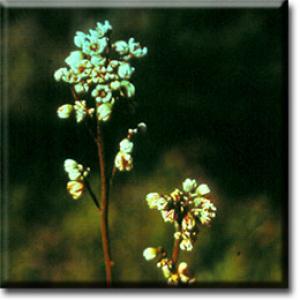
|
The Albany pitcher plant flowers in late summer, after most other plants in the region where it grows have flowered. The flowers of Cephalotus are rarely seen on cultivated plants--in part because it's a difficult plant to cultivate.
|
copyright: Carlquist, BSA
license: http://images.botany.org/index.html#license |
Image
|
Carnivorous Plants

|

|
|
setSC-Cephalotus-4
|
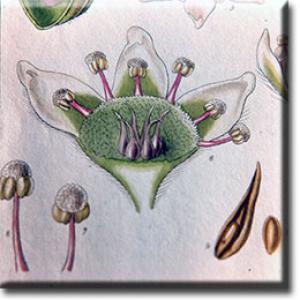
|
This old illustration from Curtis's Botanical Magazine shows that the flowers of Cephalotus have six sepals, six petals (rather hooded), six stamens. The six carpels are at the bottom of a bowl-like disk. These features are somewhat like those of saxifrages, and that was long thought to be the family closest to Cephalotaceae.
|
copyright: -
license: http://images.botany.org/index.html#license |
Image
|
Carnivorous Plants

|

|